Scott Adams's Blog, page 286
September 3, 2015
Then You Own the Bank (part of my Trump Persuasion Series)
There’s an old saying in business: If a bank gives you an average-sized loan, the bank owns you. But if you take out a gigantic loan, you own the bank.
Trump only takes out gigantic loans.
Why?
Is it because he is an egotistical clown who goes big no matter what the situation deserves?
Maybe.
But consider that going big also has the advantage of being the smartest possible thing you can do at his level. And it works almost every time for an operator with his skill.
Consider Trump’s relationship to Fox news. The other candidates took a small loan from Fox, and by that I mean they played by the rules. Trump took out a big, risky loan by going at them hard. Now he owns Fox.
Consider the Republican party. Trump’s challengers are trying to show how well their opinions fit the party platform. Trump says he will make the party platform fit Trump, much the way Reagan redefined the party in his time.
Let me give you a fresh example of how that absurd situation could happen. I am told Trump just promised he would not cut Social Security. That seems at odds with the Republican vibe of smaller government. Seems like a risky promise for a Republican candidate.
Here’s how Trump can get away with it, and no one else in the race can. And here is how he redefines the Republican party at the same time, while barely trying.
All Trump has to do is take the same approach he used with the Iran deal: “I’m a deal guy. Social Security is a deal with seniors. End of story.”
That is a high ground maneuver of the highest order. He would be untouchable.
The party would have to circle around the platform concept of being deal-keepers. That seems to be the common thread in the Trump philosophy: Make the best deal you can, then keep it. Otherwise, who wants to deal with you next time?
Who runs against that idea and wins?
Note: I remind new visitors that I am not smart enough to know who would do the best job of president. All of the candidates seem competent to me. My interests are in Trump’s persuasion and negotiation skills.
[Update: This article in Slate,
by Jim Newell, about Trump’s strategic brilliance is a good read both for the writing and the content individually.]
P.S. Wait until I tell you how Trump will use hypnosis to solve ISIS. He already started. Experts say you can’t kill an idea. Experts are wrong.

The Tells (for cognitive dissonance)
Today I offer you a new and probably different filter for interpreting your reality. You can try the filter in the same way you would try on a new pair of sunglasses. See for yourself if the new filter fits the data better than your old one. This is for entertainment only. Science is probably at a different URL.
What follows is a description of some of the tells for cognitive dissonance. If any of what follows is accurate, it might set you on a path that changes your life in delightful ways. Or maybe reading this post will do nothing but leave you with less time to interact with other people. Either way, you’re welcome.
This might be a lucky day for you.
Pay attention.
Cognitive dissonance, as I use the term in this post, refers to a situation in which a person is presented with facts that contradict that person’s self-image, causing said person to say things that sound 100% reasonable to the speaker while sounding like nonsense to others.
When I say nonsense, I do not mean a normal difference of opinion based on different values or different information. I mean serious head-scratching WTF stuff.
A tell, in this context, means an involuntary action that reveals a person’s inner thoughts in an unguarded moment. In the context of a poker game, a tell might signal a bluff. In the context of police work, a tell might signify a lie. In the context of hypnosis, a tell signifies a switch from rational thinking to irrational thinking.
A tell in this context can mean you guessed the admin password for a human being. The tell is your feedback that the words you used got translated into a physical response. That is the hypnotist’s equivalent of A-B testing. The hypnotist tries an approach and watches for the subject’s physical reaction.
Recognizing tells takes practice. The more tells you spot in your lifetime, the easier it is to find more. Your mind gets tuned to them. You recognize the pattern. You see them coming before they even happen, based on the trigger event.
Complicating all of this is the fact that each tell has a false-positive explanation that will always sound plausible. The best way to estimate the odds of a tell being the real thing is by its proximity to a known trigger. If someone exhibits a tell symptom without a trigger, it probably just means you are talking to an idiot. And that happens less than you probably assume it does. All the rest of your “idiot” encounters are smart people experiencing cognitive dissonance and not realizing it.
And now for the list of tells.
Speechless Moment. This one can only be detected when you are in the same room. When a person that is otherwise witty and verbal becomes temporarily tongue-tied, it means they are having a strong physical response to your suggestion. Use this method in your love life to identify a person’s sexual preferences in casual conversation.
Example:
Love Interest: “Sorry I am late.”
You: “You need a good spanking.” (Said with a knowing grin, for effect.)
Love Interest: [silence that last over 5 seconds]
Interpretation: A sudden “struck dumb” silence means you reached into your love interest’s subconscious and found a powerful hidden craving.
False-positive: That’s a messed-up thing to say to a nice girl you barely know. She is wondering how to end the date early.
Lone Penguin: The Lone Penguin is the person you see on the Internet imploring others to stop listening to person X. The usual phrasing looks like “Why is anyone listening to that terrible person X?”
The tell is that the Lone Penguin will offer no data or reasoning to back up the emotion. At most, the Lone Penguin will offer a link to a story in which a journalist got something wrong or out of context.
Example:
Economist: Here is my data showing that capitalism is the best system for everyone, even the poor. (This is just an example.)
Aged Hippy: “Why are we listening to this fascist? He said in an interview ten years ago that his favorite color is blue.”
—
Interpretation: The Lone Penguin hates person X because the argument made by person X is persuasive, and that violates the Lone Penguin’s identity as a person who always disagrees with person X and similar lines of thinking.
False-positive: Person X really is a total turd with no redeeming points of view. The Lone Penguin is actually just a person with good judgement.
Personal Attack: A personal attack without reason is among the strongest tells. That means the person being attacked has been so persuasive that it is shaking someone else’s self-image.
Example:
Politician: My policies will stimulate the economy. Here is the data proving that this plan worked in every country where it became law.
Citizen: That guy is a reactionary asshole
—
Interpretation: The politician’s argument is so strong that it violates the citizen’s identity as someone that is always on the other side of that particular argument. How can the citizen maintain his old self-image and still feel rational? Cognitive dissonance is triggered and anger comes out.
False-positive: The politician really is a reactionary asshole with a bad plan.
Godwin’s Law Comes Early: Named for its creator, Mike Godwin, this observation says that every online conversation will eventually invoke Hitler’s name if you wait long enough. For our purposes, the tell is that Hitler’s name comes up too soon.
Example:
Politician: I favor a tiny change in gun laws that will have no impact on legal gun ownership but might keep some guns out of the hands of criminals.
Citizen: That’s what Hitler said.
—
Interpretation: If you skip directly to Hitler without passing “why” you are probably experiencing cognitive dissonance.
False Positive: Sometimes a genocidal dictator does invade a neighboring country.
Too Many Explanations: When you see pundits or citizens offering a wide variety of explanations for an observation, it probably means no one has any idea what the real reason is. If people were rational they would say they don’t know the reason. But if cognitive dissonance sets in, people will imagine reasons and convince themselves they are real.
Example:
Pundit 1: He leads in the polls because he is an outsider.
Pundit 2: He leads in the polls because he says what people are thinking.
Pundit 3: He leads in the polls because the press likes a clown. He will fail later.
Pundit 4: He leads in the polls because people like his immigration plan.
Pundit 5: He leads in the polls because serious voters are not paying attention yet.
Pundit 6: He leads in the polls because people think he can win and people like to win.
—
Interpretation: When everyone has their own explanation, nearly all of them are in cognitive dissonance.
False-positive: Sometimes things do have more than one explanation.
Slippery Slope: Any reference to a slippery slope is a tell for cognitive dissonance because there is no logical argument that involves a slippery slope unless kids are involved. When reason fails, you go for a Hitler analogy or a slippery slope defense. They are roughly equal in absurdity.
Example:
Politician: I favor doctor-assisted suicide.
Citizen: That is a slippery slope to a cannibal society.
Interpretaton: I agree with your reasoning but it scares me because it makes me imagine something similar happening in a bad way.
False-negative: You have encountered a rare situation in which the slippery slope is a real thing. For example, allowing your kid to eat candy before dinner just one time is definitely a slippery slope.
Jokeless laugh: When I was training to be a hypnotist, our instructor taught us that a subject will often laugh at something you say, or a background sound, that would normally have no humor trigger. The real trigger is that the subject is feeling the hypnotist’s words translate into bodily reactions and it causes an involuntary giggle.
Case in point, I often find myself doubled up in laughter when I read quotes from Donald Trump. I feel the persuasion working at the same time I recognize his tricks for pulling it off. That feeling of absurdity (my mind is being changed without the benefit of reason) triggers a laugh response when there is no joke in the vicinity.
Example:
Hypnotist: Your arm feels weightless. It will start to float.
Subject: Hee hee! That lawnmower outside made a funny noise.
—
Interpretation: The subject felt her arm getting lighter, which makes no sense in her old view of how things work, and it triggered a laugh response.
False-positive: The lawn mower is actually funny for some reason.
Nonsense Rebuttal: When you hear an irrational response to your rational argument, it probably means the argument was sound but it violated someone’s sense of identity. Here I am talking about the truly illogical responses you see on the Internet all the time, not routine disagreements over data and priorities.
Example:
Other Guy: Locking up criminals forever does not reduce crime.
Me: That could only be true if for some reason law-abiding people decide to become criminals at a higher rate because the real ones are in jail.
Other Guy: It is a slippery slope.
Me: WTF?
I am sure I am leaving out lots of tells. And you will be quick to point out that the tells conveniently form a narrative that lets me be right all the time while viewing everyone else as being in a state of cognitive dissonance.
You have a good point there.
Why do I think I can spot tells more often than chance would predict? The best answer I can offer is that I think I can. My experiences are anecdotal, not measured. You are invited to be skeptical about this and all the rest of my blogging on the topic of hypnosis.
In a past post I teased you that there are some topics that can’t be communicated because of their nature. This is one of them. The rational people reading this blog should be skeptical that, for example, Trump can dominate the country using little more than good business sense and linguistic engineering. To me, that seems like an easy accomplishment for Trump, given his skill level.
Trump’s “inexplicable” success so far opens the door just enough for me to discuss this topic. If you watch him march to the White House while the pundits disagree why this “magic” is happening, my credibility on this topic will increase to the point where I can communicate with you and you will listen. There is lots more to tell.
If Trump stumbles, for any reason, the door will close and no one will think his skills at persuasion were a big thing. Most of you expect that to happen. And stumbling seems common enough that we can’t rule it out. Nate Silver, who is right more than most people, gives Trump a 2% chance of success.
But if Trump goes all the way, and the Master Wizard hypothesis fits the data best, everything you know about the world will change. I know how that will feel because a similar thing happened to me in my twenties.
You think the Trump spectacle is about politics, or money, or the usual media circus. And perhaps it is. But if he wins, it could mark a fundamental change in how humans view their place in the world. Once you see yourself as a Moist Robot, subject to programming by Master Wizards and prophets, you can never unsee it.
Let me give you a concrete way to make these tells useful.
If you get into a debate, and you suspect the other person has abandoned reason for cognitive dissonance, what do you do?
Most of you would try harder to be more rational and to provide better data. But the hypnotist sees a different problem. To the hypnotist, the problem is not the argument but the the person’s self-image. So the hypnotist might, for example, use the Big Picture move to adjust a person’s self-image until the argument starts to fit.
Example:
Arguer: Your plan is terrible because [absurd reason].
Hypnotist: You might be right. But if we are smart we will try the plan that teaches us something even if it doesn’t work. Then we will be in better shape to test the next iteration. Let’s view it as a process.
[Here the hypnotist elevates the discussion from the weeds to the Big Picture of how one finds certainty in an uncertain world. The arguer recognizes this as bigger thinking than the argument in the weeds. He does not want to be the weeds guy. He immediately adjusts his self-image from weeds-guy to big thinker. Once his self-image matches your plan, he is free to agree. That typically takes the form of over-agreeing, or amplifying the Big Picture to demonstrate allegiance to it. As in…]
Arguer: Yes, of course we need a system to rapidly test all the plans. Duh. I tried to tell you that yesterday but I got busy. And I guess we can try yours first, since you already have the details worked out.
Summary: If someone disagrees with you based on facts, provide better facts. But if someone disagrees because of cognitive dissonance, change who that person believes they are. The Big Picture move is just one way to do that.
Trump isn’t trying to change your mind on the facts. He knows voters are in cognitive dissonance half the time or more. Trump is changing who we are, until our self-images match his argument.
Don’t believe me? Wait until you see how many people that now oppose Trump’s immigration plan suddenly turn into people who understand we need a wall because good fences make good neighbors.
And you’re a good neighbor, right?
That’s just one way Trump could win you over by keeping his argument the same and modifying your self-image.
If Trump does not win the White House, for any reason, I invite you to discard the Master Wizard hypothesis I have proposed in this blog space. I would do the same in your situation.
But if he wins it all… and no one can agree why…
Before you ask, I am working on a book list that would give you a wider exposure to this way of thinking, from different and more scientific perspectives. I’m waiting for a book that I have seen in draft form that will be a must-read when it has a final title and cover. It includes science and stuff. Give me two weeks.
Scott
For more on the Moist Robot hypothesis, see my book that has been enjoyed by dozens of attractive people so far, so it must be good.

In Top Tech Blog, And how about a robot that can lay bricks? That’s what we need. Send those robots to the desert to build us affordable housing, solar energy farms, and the rest.

September 2, 2015
Build a Habit-Robot in your Brain
Did you hear about a book that is designed to put little kids to sleep when parents read it aloud?
The book uses words that act on the subconscious to make kids sleepy. Is that possible, you ask the trained hypnotist writing this post?
Yup.
I don’t know if the author executed the concept well, but the idea is well within the range of things I have seen in person. Kids are highly suggestible.
Luckily we grow out of it. By the time we are adults we can use our powers of reason to fend off the many influences coming at us from all directions. Using all the mental tools of adulthood plus our education and experience, we are able to build a mental fortress around our…
Just kidding.
We never build a defense. Words reprogram adults just as easily as kids. Donald Trump teaches us that every day. And if you want to take a desk nap, I can put you to sleep just as fast as that book for kids. But I won’t. You have things to do.
We humans think of ourselves as single entities because our bodies make each of us look like one person. I tried to maintain that illusion for most of my life and have finally released it. Now I accept that I am lots of personalities and I cycle through them during the day according to a schedule I do not set. When my body chemistry makes me confident and ambitious, I’m that guy. When my body chemistry goes in another direction, I’m another person for awhile. But those personalities are the average of what is going on in my mind at any time. And thinking of myself as the average of my mind’s competing forces was not useful to me.
My current model for what I call my “self” is that my mind is like a riot at an insane asylum. Luckily, one of the inmates was wrongly committed. That guy has the job of trying to get the real lunatics under control before the body that supports all of them does something dumb.
In my model, if the other patients are calm, the lone voice of reason can dominate the situation. It knows how to avoid the more dangerous patients and coerce the gullible ones. It makes deals. It builds alliances. It does what it can to assert itself as the only sane voice in a building full of irrational actors.
But that only works when the other patients are relatively calm. If any of them gets worked up, they are larger than the tiny rational voice and overpower it.
Where some of you see free will in this scenario, I see math. If the crazy players in my head outnumber the rational part of my mind, they win. Sometimes my rational mind uses judo-like tricks to fight above its weight class, but it is still one player in a building full of lunatics. It can’t win them all.
(Yeah, I know this sounds like an animated movie you recently saw. That’s an “anchor” I could not avoid. It just dragged your attention somewhere I don’t want it to go and slowed the flow of my post. See how hypnosis considerations are woven into writing? This is just one example.)
The insane asylum model of the mind has some advantages. In my old mental model, any form of stress felt as if all of me was having a mental problem. Now I see it as one of my fellow patients going on a rampage. I need to sedate him.
So my rational player does what it knows to do. In preparation for future riots that I know are coming, I have moved to habit (via repetition and reward) my exercise routine. If my rational mind needs to activate the habit subroutine, it can do so with a whistle even if it is already under a dog pile of crazy actors. Habits are like robot warriors that the rational part can order into combat. I activate the exercise habit-robot and try to hold off the rioting crazies until…
I go to the gym. Happy chemicals flow into my body. I stab a sedative into the biggest nut on top of me and push him off.
Lesson 1: You can’t exercise-away real problems. But most of what stresses you might not be that big. Exercise is one way to sedate the lunatic on top of you.
Lesson 2: You need a robot army in your brain to help your rational player when the crazy parts of your mind start to riot. You can build your robots as “habits” so you can call upon them when needed.
Your tiny rational voice might not have the power to overcome a hospital full of lunatics. But your robot army (the habits you engineered) can dispatch them easily.
Get yourself some mental robots by building habits.
I am putting together a reading list for people who are interested in persuasion as a craft. This book on forming habits will be one of the most important ones on the list. Think of it as a way to arm the rational part of your brain to fight off the crazy parts.
And obviously if you want to see more about the Moist Robot view of the world, you need to read my book. That will be on the list too.
—
In Top Tech Blog, you need a self-driving golf cart because the game can be exhausting if you do a bunch of steering. Who has time for that?
Scott
In other news, people on Twitter are voicing surprise that I am not totally incompetent. I really, really need to improve my brand.


September 1, 2015
Trump: The “Bad System” Linguistic Bayonette

“Bad system” is a test balloon.
Watch what happens to that phrase in the next 24 hours. If it gets quoted a lot (more than this blog would explain) it will be lethal.
Why?
Big Picture move: Fix the money, fix it all.
Who agrees with him that the system is bad? Every human alive. Even the lobbyists doing the bad.
And “system” is a fresh word. Notice he uses fresh ones, or in this case an underused one. That lets you control its content. No leakage in the way of reminding people of unrelated things.
Engineered.
I’m almost positive that the other candidates are going for 55% of the vote. Trump is going for them all. Watch what happens with his VP pick and his immigration plan. I have never seen a chess board so well set. (A big part of that is luck, obviously.) But look for some surprise flanking moves on his problem topics.
I remind you that this blog is for entertainment. I am making predictions based on Trump’s persuasion skills so you can compare the Master Wizard hypothesis to the Lucky Clown consensus in the media. See which one fits the data better as we go.
In any event, looks like we have a systems guy competing against goals people. I say systems usually win whenever the contest is long and the variables are many. We have plenty of time to find out.
Someone should write a book about that. I mean someone else. I already did mine.

Correlation or Causation: You Decide
Does reading to your kids make them smarter?
Studies show a correlation. And it seems like common sense. I am certain that reading to a kid helps the kid’s mental development.
But I also know that certainty can be nothing but a failure of imagination. I try to avoid trusting my first reaction.
So I try to think of any reason why the parents that are smart enough to follow the advice of experts and read to their kids would also have smart kids.
I got nothing.
It must be the reading that makes those kids smart, because science.
Just to be clear: Reading is good. Science is good. Science plus journalism in a click-driven business model, use caution.

Identifying the Smart Voters
What follows is an engineered set-up to induce cognitive dissonance in the reader. Do not read past the break if that sort of thing would be uncomfortable for you.
I do this as part of my series on Trump’s persuasive brilliance. You will have a better understanding of the power of cognitive dissonance when you see it displayed in the comments.
You might find it interesting that I can warn you in advance that the cognitive dissonance is coming and it will not influence the outcome. That’s one of many reasons I developed the Moist Robot hypothesis. I am going to push a button on your user interface and 80% of you will react the way I expect.
I am going describe you in a way that sounds quite reasonable and yet violates your internal idea of who you are. That will trigger cognitive dissonance, and you will see it spew into the comments over the course of the day.
My follow-up post will describe the “tells” for cognitive dissonance that hypnotists look for. I can’t describe the tells in advance without ruining the experiment. We can agree that no science is happening here. This is just for fun. And maybe we will learn something.
— cognitive dissonance experiment starts here —
According to a poll described in the Washington Post, nearly 60% of Iowa caucus voters say they don’t want to know the details of any presidential candidate’s plans. They just want the candidate to be capable.
The context of the article is that Trump is the only candidate dialed into the people. He knows the majority don’t want details and would not understand the details if provided.
Some of you just laughed out loud at the ignorance of the majority. You will lecture me in the comments about how voters should “do their own research” and reach their own conclusions. Just like you do. I hear you.
But I side with the ignorant majority.
In this case, the willfully ignorant seem a bit more enlightened about how humans are wired than the people who think we should do our own research and draw our own conclusions about politics.
In my opinion, knowing what you don’t know is a higher level of intelligence than thinking you know more than you do. And believing you can predict the future based on a candidate’s personality, backstory, and promises is the epitome of not knowing what you don’t know.
Here are just a few of the illusions that plague those of you clinging to the fantasy of human intelligence:
1. If you are trying to match a president with a job description, how can you do that without knowing what the future holds? Do we need a war president or a business-oriented deal-maker? Raise your hand if you predicted 9/11. Raise your hand if you knew oil would become cheap. And so on.
2. Candidates lie. A lot.
3. The news you hear is
biased, incomplete, or out of context
– by design – at least until history sorts it all out. Oh, and historians disagree.
4. Many of the big issues are too complicated for even the professionals to understand, much less the voters.
5. Experts disagree. About everything.
6. We believe we were right when we predicted the performance of past presidents, but only because we see what we want to see. Republicans see Obama as an unmitigated disaster of epic proportions. (Told you!) Democrats see an improved economy and more people with health insurance. (Nailed it!)
Conservatives see Reagan as the greatest of our presidents. (Yay!) Liberals see him as a guy with lucky timing and a touch of Alzheimers. (Burn!) This illusion makes each of us believe we will be good at picking the next president since we got it right the last time.
7. Past performance does not predict future performance. If you believe Reagan was a bad actor but a good president, you see my point. Whatever people were doing in the past, it wasn’t much like being president. (Governor is barely a real job.) And people’s capabilities change over time. In stock investing, the smart people understand that the past does not predict the future. In politics, people have not yet learned that lesson.
I know what you are thinking. You are thinking you CAN tell the difference between a serous candidate and a total clown with no political talent. And then Trump came along and started playing Whack-a-mole with the “real” candidates and made them look like chimps. You probably did not see that coming.
8. Citizens are not supposed to understand all of the security issues of the country. For example, one assumes the Iran nuclear deal included some side agreements on security, Israel, ISIS, and whatever. If you have an opinion on that deal, it is necessarily based on guessing.
9. We think we are good judges of character. But if that were the case, no one would ever get into a bad relationship or hire a bad employee. Humans can usually tell the difference between Godzilla and a squirrel, but that contest doesn’t come up as often as you would wish.
I’ll stop at nine reasons just because my fingers are tired of typing.
Please describe in the comments how you overcome all of those problems and manage to turn bad data into high-quality decisions by voting day.
That last sentence was the trigger for cognitive dissonance. I listed nine hard-to-refute reasons that you have been acting absurd all of your voting life, but that violates your self-image as a reasonable person. Something has to give. That triggers the cognitive dissonance. And if you have cognitive dissonance, it is by definition the thing others can see in you but you cannot see in yourself.
Tomorrow I will describe the “tells” that hypnotists look for when they induce cognitive dissonance in a subject. When you start to recognize the tells, life will never look the same.
——–
Update: I saw this Tweet right after posting, in case you want the smarter version of my point.
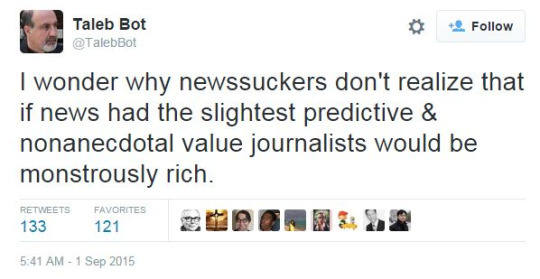
In Top Tech Blog, if you don’t like the idea of a master persuader using linguistic tricks to program a human brain like a computer, how about this new tool that will rewire your actual physical brain? Once we refine our understanding of brain architecture, nothing is stopping us from rewiring a person’s personality directly. We are not there, but probably only ten years away.
And add this mouth guard to your cyborg parts. I’m planning to skip the Age of Cyborgs – as much as I can – and port my personality directly to software as soon as possible. Literally. Probably also 10-20 years away.
——–
If you would like to see the world through a systems filter instead of a goal-oriented filter, I wrote the book on that. Unless someone else wrote one too. I probably should have checked first.

#success

August 31, 2015
Robots Read News - about Celebrity Apprentice
If you can’t see the image below because your company fire wall is being a dick, follow me on Twitter here.
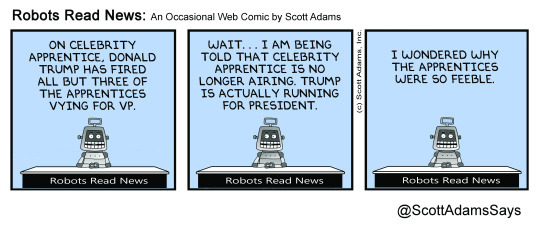
I laughed for ten minutes when it occurred to me that Carson, Fiorina, and Cruz are (in the view of many) competing for the Celebrity Apprentice spot as Vice President. Trump already fired the other contestants.
Trump is making the public think past the sale (the nomination) and focus on his match-up in the general election. Watch him steer the conversation toward Clinton (already doing so, will do more) and perhaps he will do something outrageous to increase chatter about his future VP selection.
Here’s a prediction to watch that fits the Master Wizard hypothesis. I say he will do something newsworthy on the topic of his potential choice for VP. That would focus the public’s attention past the nomination. A typical politician would not bring that topic into the fray so early. A Master Wizard would use it as an anchor to drag your attention to the future, imagining he is already nominated.
You say you can’t imagine a president Trump? I hear you. That’s how he fixes it. He will literally make you imagine it by directing you to think of his likely choices for the number two slot.
Yeah, you do know it will work.
I know most of you think there is nothing to the Master Wizard hypothesis so I will try to be predictive. It isn’t science, but it might be fun to watch the show.
I remind you again that I think all the candidates are serious people. I have no psychic ability to predict whether Trump would be more or less fabulous than any of the others.
Scott
Look for me to blog about Trump as a systems thinker with a Moist Robot view of the world. The lucky (and often sexy) people that have read my book know where I will be going with this.

Trump Engineers a Clinton Linguistic Kill Shot
An alert reader noticed that Trump is already beta-testing a linguistic kill shot for Hillary Clinton.

As Yohami accurately notes, this kill shot is also a high ground maneuver. It takes you out of the weeds of the email server question (where reasonable folks can be confused and disagree) all the way to national security where we all have the same opinion that risk is unacceptable.
Trump’s label will stick because he knows the public is not following the details of Clinton’s server security issue. They just have some general sense of distrust for all things Clinton. Trump put a label on that general distrust: “Major security risk.”
And remember how I told you in a prior post that “risk” is the magic kill word that brought supply-side economics to its knees in the Clinton/Dole election cycle?
“Security risk” is an engineered, linguistic kill shot. And it is the stake-in-the-heart that will cause Clinton to drop out early or limp to the starting line (nomination) mortally wounded.
A candidate can recover from a technical security mistake caused by the people she hired. But no presidential candidate can wash-off the label of being a “major security risk.”
And how about the word “major” in that sentence. Yup, an anchor. Trump doesn’t need you to accept that the risk is major. But setting that anchor in your mind probably makes you think there is SOME security risk with Clinton that is unique. And even the smallest extra risk in this sort of situation means we all die.
A key to making a linguistic kill shot stick is that you have to pick a fresh label that doesn’t come with any baggage. If you call someone a liberal, the other side loves it, and the word is a bit ragged and empty in 2015.
But if you call Bush “low-energy” you have a fresh field. No one ever used that label for a candidate. It sticks because the label had no baggage to bring with it. Likewise, “major security risk” is a label no candidate ever had to fend off. It is fresh and sticky.
And engineered.
Still think Trump is winging it?
——-
In Top Tech Blog, I want one of those lasers that can knock drones out of the sky. My neighbor has a drone and I think it would be fun to have anti-aircraft defenses along my property line. Just in case.
And when NASA starts 3D-printing rocket parts, you know it means your grandkids will be someday vacationing on another planet.
——-
Bonus Thought: This quote today from an article in BusinessInsider.com.
“According to the poll, 61% of Iowa Republicans now view him (Trump) either mostly or very favorably, compared with just 35% who see him in an unfavorable light. That’s almost directly contrasted with their views in a May poll by the same firm — then, Iowa Republicans viewed him unfavorably by a 63-27 margin.”
Right on schedule.
—
I wrote a book that has all kinds of words in it, often in the form of complete sentences. People like it.


August 30, 2015
A Glimpse Into the Creative Writing Process
At about 11 PM last night, I was locking my doors and turning out the lights to go to bed. It had been a long day, mostly work. My mind was everywhere, as usual, flitting from one topic to another, as my body, operating mostly on habit, went through its evening routine.
Suddenly, and for no particular reason that I can identify, a thought started forming in my head. It wasn’t a normal one. I knew that right away. I had an almost tactile sensation of the thought trying to birth itself by collecting language around it to form a sentence. It felt as if I heard the sentence – in the way you hear yourself think – before I had a sense of its meaning.
All of this lasted three seconds, at most. The thought was born fully-formed, which is rare for me. Most thoughts start raw and need refinement. Not this one. There was something different about it from the start. But what? I could almost feel it trying to get out of my body.
I pulled out my phone and tweeted it. By then my body was vibrating.
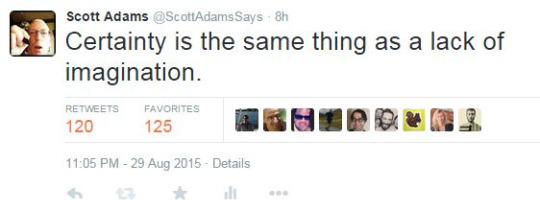
And then I went to bed.
I woke up to find that my tweet might be among the most viral things I have ever written (although it is still early). And I don’t know where the thought came from. It simply appeared in my head. Or at least that is my experience of it.
When people ask me where I get my ideas, I have lots of writerly answers for that. I usually talk about inhaling stimulation from the environment and exhaling some of it back with a creative flare. Sometimes I say I copy other art, but do it so poorly that it looks original. Sometimes I say people send me ideas by email, but those are only broad topic suggestions. Sometimes I say I was born with the right wiring for creativity. Sometimes I say creativity is like a muscle that you can exercise, and I exercise it every day for my job, so that must help, I would think.
But all of that blah, blah really speaks to the craft part of creativity. Creativity is the part you do intentionally. Art is the part you discover. Or in this case, it discovered me.
The experience I described from last night is uncommon for me, but only because of the high wattage. When I write, I am running a program in my mind that checks the logic and grammar of my writing, of course. But I am also monitoring all of my thoughts for their visceral impact. In other words, I tune my physical body to feel words and ideas. My body is the instrument that identifies the x-factor, not my mind. If you don’t feel an idea in your body, no one else will either.
If you want to inform, write with your mind. If you want to move people, write with your body.
Scott
Follow me on Twitter at: @ScottAdamsSays
—
Note: Yes, I know all the “feeling” happens in my head. But you know what I meant. And that is your bonus writing tip for the day: Sometimes writing it wrong is writing it better.
—
If you want to see a book that has plenty of body-writing, see my book on systems versus goals. A book of this sort is only useful if it moves people to action, so I went heavy on the body-writing.


August 29, 2015
Robots Read News (NSFW)
Some saucy language is below the break. Please read no further if that sort of thing bothers you.
I am aware that the following comics will only appeal to a narrow audience. This is for them.
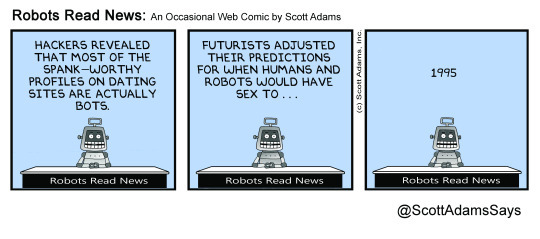
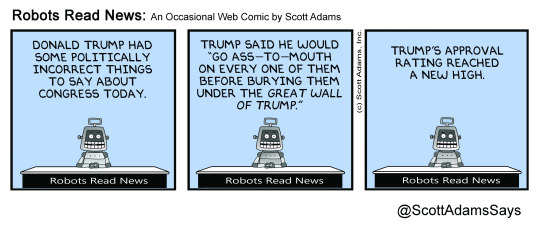

Scott Adams's Blog
- Scott Adams's profile
- 1258 followers



